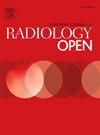CT-based deep learning radiomics analysis for preoperative Lauren classification in gastric cancer and explore the tumor microenvironment
IF 2.9
Q3 RADIOLOGY, NUCLEAR MEDICINE & MEDICAL IMAGING
引用次数: 0
Abstract
Purpose
This study aimed to investigate the usefulness of CT-based deep learning radiomics analysis (DLRA) for preoperatively differentiating Lauren classification in gastric cancer (GC) patients and explore the tumor microenvironment.
Methods
578 patients were recruited from January 2015 to June 2024, and divided into the training cohort (n = 311), the internal validation cohort (n = 132), and the external validation cohort (n = 135). Clinical characteristics were collected. Radiomics features were extracted from CT images at arterial phase (AP) and venous phase (VP). A radiomics nomogram incorporating radiomics signature and clinical information was built for distinguishing Lauren classification, and its discrimination, calibration, and clinical usefulness were evaluated. RNA sequencing data from The Cancer Imaging Archive database were used to perform transcriptomics analysis.
Results
The nomogram incorporating the two radiomics signatures and clinical characteristics exhibited good discrimination of Lauren classification on all cohorts [overall C-indexes 0.815 (95 % CI: 0.739–0.869) in the training cohort, 0.785 (95 % CI: 0.702–0.834) in the internal validation cohort, 0.756 (95 % CI: 0.685–0.816) in the external validation cohort]. It outperformed the clinical model in predictive ability. The calibration and decision curve substantiated the model's excellent fitness and clinical applicability. Further, transcriptomics analysis showed that the differentially expressed genes of different Lauren types were mainly enriched in pathways related to cell contraction and migration, and the infiltration degree of various immune cells was also significantly different.
Conclusions
DLRA effectively differentiated Lauren classification in GC, and our analysis of transcriptomic data across different Lauren subtypes revealed the heterogeneity within the GC microenvironment.
基于ct的深度学习放射组学分析胃癌术前Lauren分型及肿瘤微环境探讨
目的探讨基于ct的深度学习放射组学分析(DLRA)在胃癌(GC)患者术前Lauren分型及肿瘤微环境的应用价值。方法2015年1月至2024年6月共招募患者s578例,分为训练队列(n = 311)、内部验证队列(n = 132)和外部验证队列(n = 135)。收集临床特征。从动脉期(AP)和静脉期(VP) CT图像中提取放射组学特征。建立了结合放射组学特征和临床信息的放射组学图,以区分Lauren分类,并对其识别、校准和临床有用性进行了评估。来自The Cancer Imaging Archive数据库的RNA测序数据被用于转录组学分析。结果结合两个放射组学特征和临床特征的nomogram对所有队列的Lauren分类都有很好的区分[训练队列的总c -指数为0.815(95 % CI: 0.739 ~ 0.869),内部验证队列为0.785(95 % CI: 0.702 ~ 0.834),外部验证队列为0.756(95 % CI: 0.685 ~ 0.816)]。其预测能力优于临床模型。校正曲线和决策曲线证明了该模型具有良好的适应度和临床适用性。此外,转录组学分析显示,不同劳伦类型的差异表达基因主要富集于细胞收缩和迁移相关的通路,各种免疫细胞的浸润程度也有显著差异。结论sdlra有效区分了Lauren在GC中的分类,我们对不同Lauren亚型的转录组学数据分析揭示了GC微环境中的异质性。
本文章由计算机程序翻译,如有差异,请以英文原文为准。
求助全文
约1分钟内获得全文
求助全文
来源期刊

European Journal of Radiology Open
Medicine-Radiology, Nuclear Medicine and Imaging
CiteScore
4.10
自引率
5.00%
发文量
55
审稿时长
51 days
 求助内容:
求助内容: 应助结果提醒方式:
应助结果提醒方式:


